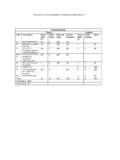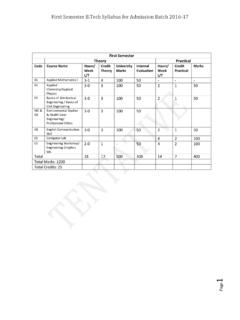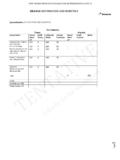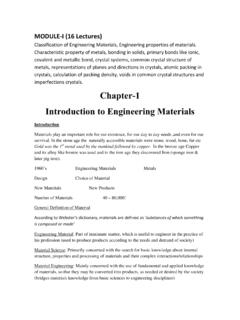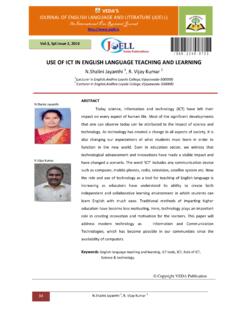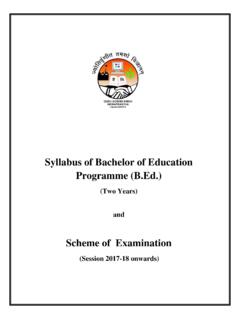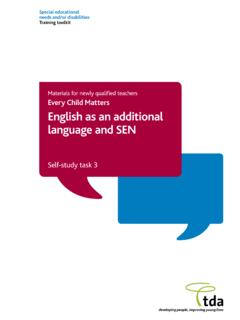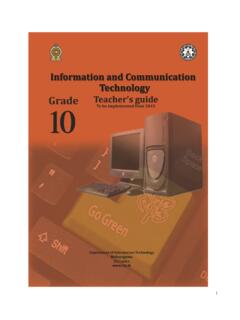Transcription of Subject: ENGLISH COMMUNICATION SKILLS (THEORY) …
1 1 Subject: ENGLISH COMMUNICATION SKILLS (THEORY) Subject Code: HM3101 Branch: all branches Semester: (IST SEM) Lecture notes prepared by: i) Dr. Minakshi Prasad Mishra (Coordinator) Asst. Prof. in ENGLISH College of Engineering and Technology, Bhubaneswar BPUT Email: ii) Ms. Parinita Tripathy Lecturer in ENGLISH College of Engineering and Technology, Bhubaneswar BPUT iii) Ms. Ranjita Patra Lecturer in ENGLISH College of Engineering and Technology, Bhubaneswar BPUT 2 Disclaimer: The lecture notes has been prepared by referring to many books and notes prepared by the teachers. Some of the books referred has not been given reference in the foot notes, but referred only once in the end notes.
2 This document does not claim any originality and cannot be used as a substitute for prescribed textbooks. The information presented here is merely a collection of materials by the committee members of the subject. This is just an additional tool for the teaching-learning process. The teachers who teach in the class room, generally prepare lecture notes to give direction to the class. These notes is just a digital format of the same. These notes does not claim to be original and cannot be taken as a text book. These notes has been prepared to help the students of BPUT in their preparation for the examination. This is going to give them a broad idea about the curriculum.
3 Various sources as mentioned at the reference of the document as well as freely available material from internet were consulted for preparing this document. The ownership of the information lies with the respective authors or institutions. Further, this document is not intended to be used for commercial purpose and the committee faculty members are not accountable for any issues, legal or otherwise, arising out of use of this document. The committee faculty members make no representations or warranties with respect to the accuracy or completeness of the contents of this document and specifically disclaim any implied warranties of merchantability or fitness for a particular purpose.
4 3 Preamble: Course outcome Today s engineers face a dual challenge of being competitive as well as global. They not only have to be master in their professional SKILLS but also, they must have various soft SKILLS competencies to be suitable for the job market. In today s date the job market is growing in terms of volume but it is shrinking in terms of number of professionals passing out of the college. The students who pass out their degree must possess the qualities of a techno-manager. They must be in a position to do multitasking in their jobs. Only possessing technical SKILLS /hard SKILLS have not paid off for many. Hence, keeping in view the requirement of the job market it was understood that the students need to be good at Soft SKILLS too.
5 One of the most important tool for good soft SKILLS is COMMUNICATION SKILLS . COMMUNICATION SKILLS means ENGLISH COMMUNICATION SKILLS . COMMUNICATION SKILLS helps a student in developing Confidence, smartness and outward SKILLS . This course has been designed keeping in mind the need of the Engineering students and their future needs. All the three modules discussed in the curriculum is highly essential and helps a professional to speak better ENGLISH . A thorough research has gone into the design of the curriculum. The digital notes prepared will help to enhance the understanding on the subject. The students are advised to use the digital notes for the purpose of reference only.
6 They have go through many books in order to understand individual subjects. The course will help in getting a better idea on different topics, hence, increasing the competency of the students in the subject. 4 Syllabus Module-I The elements of COMMUNICATION The importance of COMMUNICATION through ENGLISH at the present time The process of COMMUNICATION and factors that influence COMMUNICATION sender, receiver, channel, code, topic, message, context, feedback, noise, filters & barriers The importance of audience and purpose The information gap principle: given and new information, information overload Verbal and non-verbal COMMUNICATION : body language Comparing general COMMUNICATION and business COMMUNICATION Module-II The sounds of ENGLISH Vowels, diphthongs, consonants, consonant clusters The International Phonetic Alphabet (IPA).
7 Phonemic transcription Problem Sounds Syllable division and word stress Sentence rhythm and weak forms Contrastive stress in sentences to highlight different words Intonation: Falling, rising and falling-rising tones Varieties of Spoken ENGLISH : Standard Indian, American and British (Note: This unit should be taught in a simple, non-technical manner, avoiding technical terms as far as possible.) Module- III Review of ENGLISH grammar Static and Dynamic Verbs The auxiliary system: finite and non-finite verbs Time, tense and aspect Voice: Active and passive Modality Negation 5 Interrogation: reported and tag questions Conditionals, Concord Phrasal Verbs (Note: The teaching of grammar should be treated as a diagnostic and remedial activity and integrated with COMMUNICATION practice.)
8 The areas of grammar in which errors are common should receive special attention when selecting items for review. Teaching need not be confined to the topics listed above.) Books Recommended: 1) An introduction to Professional ENGLISH and Soft SKILLS by B. K. Das et al., Cambridge University Press (Facilitated by BPUT) 2) Technical COMMUNICATION : Principles and Practice, Second Edition by Meenakshi Raman and Sangeeta Sharma, Oxford Publications. 3) Effective Technical COMMUNICATION by M Ashraf Rizvi, The McGraw-Hill companies. 4) Understanding Body language by Alan Pease. 5) Communicative Grammar of ENGLISH by Geoffrey Leech and Ian Svartik. 6) Better ENGLISH Pronunciation by Connor.
9 7) ENGLISH Grammar by Corder 8) ENGLISH Grammar by Wren and Martin. This is not the end of the list other books may also be referred. 6 Lesson Plan: The course should be taught in an interactive method. Use of black board as well ICT is highly useful for delivering the topics. The first module has to be completed in 6 hours hence, the module has been divided into six sessions of one hour each. Session 1: Importance of COMMUNICATION in the present context, Introduction to COMMUNICATION . Session 2: Process of COMMUNICATION and Factors that influence the process. Session 3: Importance of audience and purpose. Session 4: The information gap principle: Given and new information, information overload.
10 Session 5: Verbal and non-verbal COMMUNICATION (Body language ) Session 6: Comparison between general COMMUNICATION and Business COMMUNICATION , review of the module. The second module is to be completed in 14 hrs. hence the second module is divided into 14 sessions of one hour each. Session 7: Introduction to phonetics, need and use of it. Session 8: Received pronunciation, transformation of letters into sounds. Session 9: International phonemic alphabets, Vowel Sounds, Consonant Sounds Session 10: Consonant Clusters and its use. Session 11: Phonemic transcription Session 12: Phonemic transcription Session 13: Syllable division and word practice Session 14: Word stress and Sentence stress Session 15: Problem sounds and Sentence rhythm 7 Session 16: Weak forms Session 17: Contrastive stress in sentences to highlight different words.
